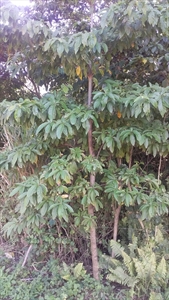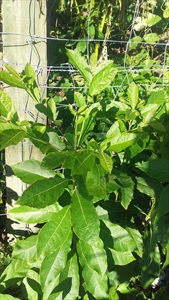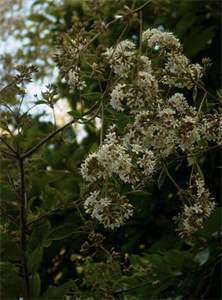Ecuador laurel. It is also known as Spanish elm, salmwood, cypre.
Pacific Pests, Pathogens, Weeds & Pesticides - Online edition
Pacific Pests, Pathogens, Weeds & Pesticides
Ecuador laurel (Cordia) (496)
Cordia alliodora; previously, it was known as Cerdana alliiodora. It is a member of the Boraginaceae.
Africa (Tanzania), North (Hawaii, Mexico), South and Central America, the Caribbean, Oceania. It is recorded from Federated States of Micronesia, Fiji, Papua New Guinea, Samoa, Solomon Islands, Tonga, and Vanuatu. A native of tropical America.
A fast-growing pioneer tree invasive in agricultural land, e.g., coffee and cocoa plantations, pastures, roadsides, and in land used for shifting cultivation. Adapted to disturbed land, and poor soils, in both dry and wet forests, but growing vigorously in full sunlight, in fertile, freely-drained soils, and rainfall between 2000 to 5000 cm annually (Photo 1). Large seed production. From sea level to 1000 masl.
Up to 35 m, but generally 25 m, about 50 cm diameter at chest height, with branches at the same level around the trunk (Photos 2&3). Leaves lance-shaped to oval, mostly 7-15 cm long by 3-8 cm wide, slightly rough or sandpaper feel, on leaf stalks 1-3 cm, covered in soft hairs, or hairless (Photo 4). Groups of flowers born in axil of leaves or at ends of branches, up to 30 cm across; individually, flowers white, with five lobes, 5-7 mm long, surrounded by 10-ribbed, leaf-like structures (calyx), 4-6 mm long (Photos 5-7). Fruit, cylindrical, about 5 mm long, surrounded by remains of the flower.
Spread over short distances is by root suckers. Longer distance spread is by seeds on the wind. Mature fruit is shed with the remains of flowers attached which acts as parachutes. It is also associated with the distribution of trees worldwide for shade over coffee and cocoa, and the establishment of forest plantations.
Plantation programs in Vanuatu during the 1970s have shown detrimental impact from this species on native ecosystems, particularly on the islands or Eromango and Maewo. It has been described as an environmental nuisance, overtaking natural forests by multiplying at a faster rate, and spreading to adjacent land. Problems occurred where plantations were used for pastures in their early years, becoming overgrazed, and subsequently colonised by Ecuador laurel.
In Tonga, it is considered an invasive species on 'Eua where it was introduced as a timber tree. Similar problems are reported from Yap and possibly other parts of Federated States of Micronesia, and Samoa.
The wood has many uses: for boat decking, oars, windows, doors, flooring, rafters, furniture, veneer, and musical instruments; it is sometimes used as a substitute for mahogany or teak. Fruits are edible though said not to be very tasty! There are medicinal uses reported for stomach, intestines and lungs. It is also used in agroforestry systems, e.g., with cocoa and coffee as shade, and also in pastures.
BIOSECURITY
The chances of introduction of Ecuador laurel is high. Countries not yet infested with this tree should consider all likely pathways for entry, and apply quarantine measures accordingly. Particular attention should be given to its spread as seed. It is available for purchase on the Internet. Biosecurity aspects of invasive species (including Cordia alliodora) that impact on forests of Vanuatu have been recorded by FAO: (http://www.fao.org/policy-support/tools-and-publications/resources-details/en/c/1273752/).
BIOLOGICAL CONTROL
Not a method recommended for Ecuador laurel. A natural enemy includes the root rot pathogen, Phellinus noxius, in Vanuatu (see Fact sheet no. 03), spreading from local nutmeg. The impact of this pathogen on Cordia and other species is not well reported.
CULTURAL CONTROL
- Physical & Mechanical:
- Hand-pulling seedlings is possible.
- Slash saplings. However, stems should not be left on site as they will sprout from cut ends. They should be collected and burned.
CHEMICAL CONTROL
Use systemic herbicides, such as triclopyr, 2,4-D, applied to the basal bark or cut stems, about 15 cm above ground level, and spray immediately with herbicide. Check for regrowth.
____________________
When using a pesticide, always wear protective clothing and follow the instructions on the product label, such as dosage, timing of application, and pre-harvest interval. Recommendations will vary with the crop and system of cultivation. Expert advice on the most appropriate herbicides to use should always be sought from local agricultural authorities.
AUTHOR Grahame Jackson
Information from Ken Fern 2021) Tropical Plants Database. (tropical.theferns.info/viewtropical.php?id=Cordia+alliodora); and Cordia alliodora (Ruiz & Pavon) Oken, Boraginaceae (2013) Pacific Island Ecosystems at Risk (PIER). (http://www.hear.org/pier/species/cordia_alliodora.htm); and from CABI (2019) Cordia alliodora (Ecuador laurel). Invasive Species Compendium. (https://www.cabi.org/isc/datasheet/15353). Photos 1-3 Emeline 'Ahoafi Vaini Research Station, Tonga. Photos 4-7 Karen Bix (2011) Cordia alliodora (salmwood). BioNET-EASFRINET Keys and Fact sheets. Taxonomy for Development in East Africa. (https://keys.lucidcentral.org/keys/v3/eafrinet/weeds/key/weeds/Media/Html/Cordia_alliodora_(Salmwood).htm);
Produced with support from the Australian Centre for International Agricultural Research under project HORT/2016/185: Responding to emerging pest and disease threats to horticulture in the Pacific islands, implemented by the University of Queensland and the Secretariat of the Pacific Community.










